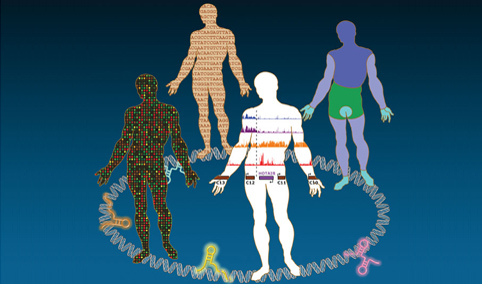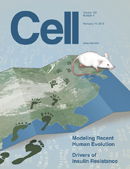我们的细胞中进行着激烈的基因战争,入侵的外源DNA频频试图破坏人类的基因蓝图。现在,加州大学旧金山分校UCSF的研究人员发现了,细胞保护自身基因抵抗入侵者的新分子机制。

这一机制负责识别和靶标外源DNA,被研究人员称为SCANR。UCSF的研究人员是在酵母中发现SCANR机制的,由于酵母与人类细胞很相似,他们认为人体中也可能存在类似机制。这样的机制有助于减少人类遗传性疾病和与之相关的死亡。
SCANR的目标是被称为转座子的小片段DNA,对于一些新生儿来说,转座子是有致命威胁的。在从简单的细菌到复杂的人类,转座子都广泛存在,这些进入宿主基因组的转座子来源于其他物种。
生物本身的基因在细胞分裂中只复制一次,但转座子(也称为跳跃基因)不同,它们会多次复制,并随机插入到宿主细胞的DNA中。如果转座子插入到重要基因中,就会使基因功能发生故障,引发疾病或出生缺陷。
正如免疫系统能够识别外源入侵者一样,UCSF Hiten Madhani博士领导的研究人员发现,细胞核中的遗传学机制通过SCANR来识别和靶标转座子。这项研究发表在二月十三日的Cell杂志上。
“我们知道,有一部分人类遗传病是由可移动的遗传元件引起的,” Madhani说。“现在我们发现,细胞是在基因表达的一个步骤中区分“我”与“非我”,从而阻止转座子扩散。”
永远的基因战争
在进化过程中,转座子频繁跨越物种界限,闯入宿主基因组。快速演化的细菌往往利用它们来传递抗生素抗性。
人类基因组近一半的DNA都含有转座子,在一代又一代的传承中,这样的百分比还会增加。这是因为,约20%的转座子复制不受到细胞分裂时DNA复制规则的约束。尽管如此,随着时间推移,在世代交替中大多数转座子失去活性而不再成为威胁。
据UCSF的生化和生物物理学教授Madhani介绍,人类基因组中存在大量的转座子,荷花基因组有99%源自于转座子。低等生物蝾螈(salamander)的基因数与人类相同,但由于转座子复制,其基因组可以比人类大约四十倍。为此,蝾螈的细胞也比人类细胞大。
Barbara McClintock在玉米中发现了跳跃基因,Richard Roberts和Phillip Sharp发现染色体上的基因会被内含子分隔,而Andrew Fire和Craig Mello则发现了RNA干涉现象。这些都是曾经获得诺贝尔奖的重要发现,以此为基础,UCSF的研究人员在酵母Cryptococcus neoformans中揭示了SCANR及其靶标转座子的机制。
研究显示,当细胞剪切装置遇到转座子这样的内含子时,就会停滞。而SCANR识别这一故障,启动合成相应的“小干涉RNA”分子,用来中和转座子的RNA。
“科学家们可能会发现,高等生物基因差异性表达的许多途径,与SCANR机制中的内含子剪切类似。这样的机制有助于识别外源基因并加以抵御,” Madhani说。

 StalledSpliceosomes Are a Signal for RNAi-Mediated Genome Defense
StalledSpliceosomes Are a Signal for RNAi-Mediated Genome Defense
PhillipA. Dumesic, Prashanthi Natarajan, Changbin Chen, Ines A. Drinnenberg, BenjaminJ. Schiller, James Thompson, James J. Moresco, John R. Yates, David P. Bartel,Hiten D. Madhani
Using theyeast Cryptococcus neoformans, we describe a mechanism by which transposons areinitially targeted for RNAi-mediated genome defense. We show thatintron-containing mRNA precursors template siRNA synthesis. We identify aSpliceosome-Coupled And Nuclear RNAi (SCANR) complex required for siRNAsynthesis and demonstrate that it physically associates with the spliceosome.We find that RNAi target transcripts are distinguished by suboptimal intronsand abnormally high occupancy on spliceosomes. Functional investigationsdemonstrate that the stalling of mRNA precursors on spliceosomes is requiredfor siRNA accumulation. Lariat debranching enzyme is also necessary for siRNAproduction, suggesting a requirement for processing of stalled splicing intermediates.We propose that recognition of mRNA precursors by the SCANR complex is inkinetic competition with splicing, thereby promoting siRNA production fromtransposon transcripts stalled on spliceosomes. Disparity in the strength ofexpression signals encoded by transposons versus host genes offers an avenuefor the evolution of genome defense.
文献链接:StalledSpliceosomes Are a Signal for RNAi-Mediated Genome Defense







